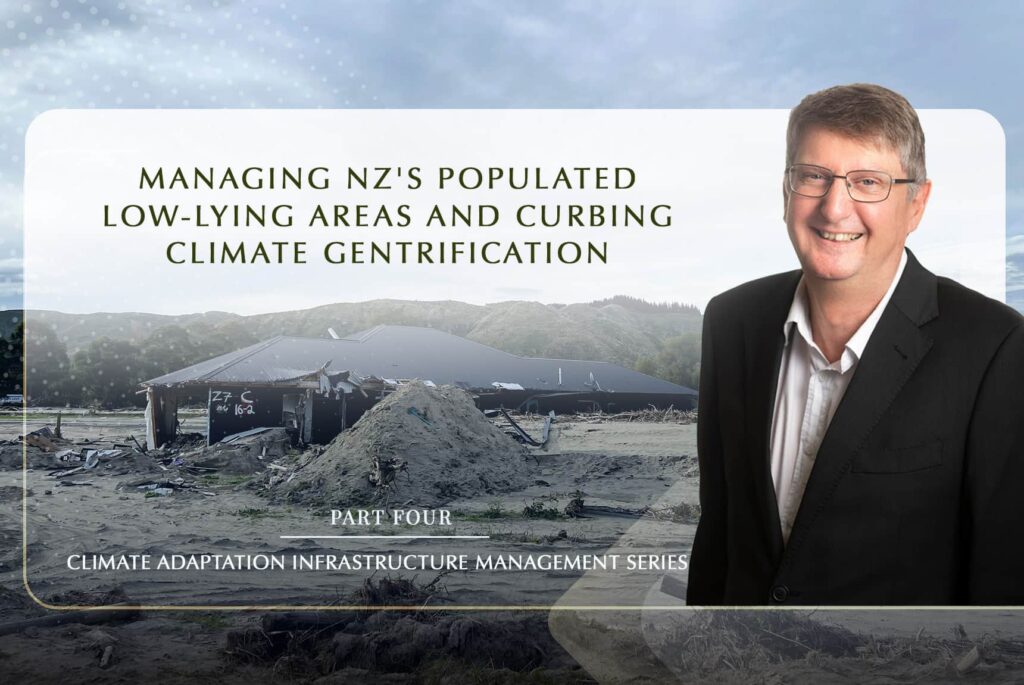Climate Adaptation Infrastructure Management Series Part 4

This is the 4th and final instalment of our blog post series on Ross Waugh’s answers to various topics related to climate change adaptation in New Zealand.
In this post, Ross discusses addressing the populated flood-prone areas in the country, incentives for adapting to climate change, and how to avoid climate gentrification.
Feasibility of a managed retreat
The Ministry for the Environment says that about 675,000 New Zealanders, or 1 in 7, live in flood-prone areas from rainfall and overflowing rivers. Moving these people and properties from these areas will take hundreds of billions of dollars. Is this possible? Aside from costs, what needs to happen or the factors involved to make managed retreat possible?
Ross:
We’ve got a good discussion about that, overtime yes, it is possible.
An interesting thing about New Zealand is that we have built towns and abandoned them—the mining booms in New Zealand in the Coromandel, West Coast, and Central Otago. Central Otago’s Chinese community would be a perfect example. These Chinese miners’ cottages have been abandoned, and Dunedin has a strong remnant community.
Most societies have a history of leaving an area because of a natural disaster such as a volcanic eruption like what happened in the Philippines during the Mount Pinatubo volcano eruption. Clark Airbase must be quickly evacuated because it was within the pyroclastic flows. Yes, we can move, but it’s more challenging if you have to do it fast. In the interim, you’ve got to work out your resilience and adaptation measures.
This is where you can start talking about staged retreats. You can leave the coast in graduated steps or add stop banks or coastal protection works. Yes, we can do retreat, but it has to be planned and managed and involves ongoing top-notch communication.
Incentives for people to adapt
In what ways the government could encourage people to take adaptive measures to cope with climate change? In the US and other countries, their governments have begun to acknowledge the importance of permeable surfaces and have offered tax rebates or refunds to residents if they replace their impervious pavements with porous ones, especially in highly urbanised areas. Can this be further applied, or is this feasible in the New Zealand context?
Ross:
Yes, there are lots of ways to apply incentives.
As we discussed earlier, the property’s insurability is the starting point because you cannot do anything with the property otherwise.
From an infrastructure government point of view, you update your planning laws, policies, legislations, and codes of practice around the permeable surfaces, and everything new that is being built follows these updated regulations, codes, and policies, including your retrofits. There’s been work going here and there in various places but not as a concerted national effort.
Curbing climate gentrification
There is a concern that only the wealthy people in New Zealand can afford to leave the area and move to safer locations, leaving behind the poor who do not have the means to move to vulnerable areas. Is this true, and how can this be prevented?
Ross:
This is a worldwide issue, and I’ve been up to Asia, South Africa, and even here in New Zealand in South Canterbury, where there are little fishing huts at the river mouths designed for weekend fishing.
There are now permanent residents in them. They are basic huts and are not designed for people to live full-time. But because of socio-economic conditions, people live there full time because the rents are cheap even though they are not warm, not insulated, and also vulnerable to flooding.
Certainly, poor people around the world are often living in flood-prone areas or by the coast. Establishing equitable responses even in New Zealand, where we are a relatively rich society, despite what you might read in today’s paper, on the world’s terms, we are in the OECD. But our equitable responses are going to stretch. Rich countries are going to stretch their resources to help lower-income countries.
How do you deal with it? Through clear policy frameworks about how to build new housing and how to move people in the most equitable way possible.
In New Zealand, we would also add government support frameworks around that as well, which might be an extension of the existing social welfare system. But at a fundamental level, you’ve got to build broad societal consensus and agreement (like what happened in Dunedin) and implement them.
What’s interesting about climate change is that it affects everyone, and the idea that some people can abandon others does not work because people who are abandoned might object to that or lead to the breakdown of society.
Our country had just been hit by two big storms, leaving damage and severely impacting people. But over the next 50 to 70 years, New Zealand will be one of the least affected countries in the world by climate change.
One of the real concerns when you read the IPCC, is the massive potential for social dislocation and strife because of climate change. How you avoid that is to look after people, which is fundamental to the New Zealand ethos, and make sure that everybody gets a fair go at stuff.
People will be impacted by something that is way beyond anything they can do to change, and it has nothing to do with their choices.
Because climate change impacts are getting massive, how do we as a society facilitate the transition and go forward? It will include welcoming people here and building new climate-resistant infrastructure that meets standards and is resilient against what’s coming, such as cyclones, rainfalls, flooding, coastal inundation, and sea level rise.
But we’re only at the beginning of the discussion; it is as much a political and social one and way wider than an infrastructure discussion. Infrastructure obviously needs to be planned and developed, and it has to be resilient so that society can continue.
An example of that is seen in the Netherlands. In 1953, they had a massive North Atlantic storm that breached the main seawalls, dykes, and coastal protection. About a third of the country went underwater. So whole villages were flooded, massive amounts of livestock were drowned, and 1,836 people died. Seventy-two thousand people were evacuated, 4,300 houses were destroyed, and 43,000 buildings were damaged. The total damage was estimated at 5.4 billion euros in today’s money.
Dutch readers will know that there is a phrase in Dutch that says, “never again”, and it became the basis of their public policy. So rather than designing 1 in 200-year event seawalls, the main Atlantic seawalls are in excess of 1 in 10,000-year events.
They are massive and come at a cost, but the whole of their society said that they are prepared to pay that cost because that flood will never happen again. An example of getting the entire society agreement that says we are not going to expose a whole town to death because we can’t be bothered spending a little bit of money to make sure it does not happen.
The minute you get to that point, you’ve got a programme of public works, infrastructure building, house building, and social programmes to assist with relocations. But you can’t do that if every three years you fight over whether or not you want to go this far that way.
When you look at the Dutch example is a very good one, and they did not do it for two years either; that build-out was over decades. The Netherlands now has some of the best engineering universities in the world around sea level protection and pumping systems and modelling of that, which is understandable because they did all that work. They build a robust multiple-level defence system to ensure they don’t get flooded, as they are a very low-lying country.
One of the answers to the climate gentrification problem is you need to have a broad societal discussion and get to a point where you get a societal consensus and agreement on what to do as a society and achieve that, then implement it.
But that does not completely solve the problem because we will have some massive storms, and there will always be one that is bigger than you plan for, but at least you’ve done all the work you can at that point to prepare. Some of that will go back to what Civil Defence Emergency Management has been doing, where you teach school kids to be resilient and families what to do during disasters and weather events to stay safe.
I have seen footage in Fiji, where they had a large cyclone, and in the Philippines, where they had a huge typhoon in the last while that you don’t go out and dance in the typhoon generally. Because stuff is flying around, you get in somewhere safe and stay there. Everybody knows that. Those who don’t follow that good advice are not here with us now.
So, it is about building community resilience as part of the discussion – this is what we do when these things happen, and this is how we stay safe. You can always build stuff afterwards, but if somebody gets lost or a family gets swept away, they don’t return, so this is the tragic part.

About the Author
Ross Waugh is the founder and director of Waugh Infrastructure Management. He is an asset management and systems integrations specialist with over three decades of experience.
His company provides infrastructure asset management consulting in transportation, utilities, community facilities, parks, and properties in New Zealand and overseas.
He also co-leads the Climate Adaptation Platform, designed as a portal for recent, relevant information to support governments and councils to help them adapt and be resilient to climate change effects.


Leave a Reply